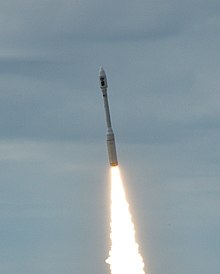
Back Тавър (ракета) Bulgarian Minotaur-C Czech Minotaur-C German Taurus (cohete) Spanish تاوروس Persian Taurus (raketti) Finnish Minotaur-C French Taurus (foguete) Galician טאורוס (משגר לוויינים) HE Minotaur-C Hungarian
 Minotaur-C launching its return-to-flight in 2017 | |
| Function | Orbital launch vehicle |
|---|---|
| Manufacturer | Orbital Sciences, Orbital ATK, Northrop Grumman |
| Country of origin | United States |
| Cost per launch | US$40−50 million [1] |
| Size | |
| Height | 27.9 m (92 ft)[citation needed] |
| Diameter | 2.35 m (7 ft 9 in)[citation needed] |
| Mass | 73,000 kg (161,000 lb)[citation needed] |
| Stages | 4 |
| Capacity | |
| Payload to LEO | |
| Mass | 1,458 kg (3,214 lb) |
| Payload to SSO | |
| Mass | 1,054 kg (2,324 lb) |
| Launch history | |
| Status | Active |
| Launch sites | Vandenberg, SLC-576E |
| Total launches | 10 |
| Success(es) | 7 |
| Failure(s) | 3 |
| First flight | 13 March 1994, 22:32 UTC USA 101 / USA 102 |
| Last flight | 31 October 2017, 21:37 UTC |
| First stage – Castor 120 | |
| Powered by | 1 Solid |
| Maximum thrust | 1,606.6 kN (361,200 lbf) |
| Specific impulse | 286 s (2.80 km/s) |
| Burn time | 83 seconds |
| Propellant | Solid |
| Second stage – Taurus-1 | |
| Powered by | 1 Solid |
| Maximum thrust | 484.9 kN (109,000 lbf) |
| Specific impulse | 285 s (2.79 km/s) |
| Burn time | 73 seconds |
| Propellant | Solid |
| Third stage – Pegasus-2 | |
| Powered by | 1 Solid |
| Maximum thrust | 118.2 kN (26,600 lbf) |
| Specific impulse | 292 s (2.86 km/s) |
| Burn time | 73 seconds |
| Propellant | Solid |
| Fourth stage – Pegasus-3 | |
| Powered by | 1 Solid |
| Maximum thrust | 34.57 kN (7,770 lbf) |
| Specific impulse | 293 s (2.87 km/s) |
| Burn time | 65 seconds |
| Propellant | Solid |
Minotaur-C (Minotaur Commercial), formerly known as Taurus[1] or Taurus XL, is a four stage solid fueled launch vehicle built in the United States by Orbital Sciences (now Northrop Grumman) and launched from SLC-576E at California's Vandenberg Air Force Base. It is based on the air-launched Pegasus rocket from the same manufacturer, utilizing a "zeroth stage" in place of an airplane. The Minotaur-C is able to carry a maximum payload of around 1458 kg into a low Earth orbit (LEO).[2]
First launched in 1994, it has successfully completed seven out of a total of ten military and commercial missions.[3] Three of four launches between 2001 and 2011 ended in failure, including the 24 February 2009 launch of the Orbiting Carbon Observatory mission[4] and the 4 March 2011 launch of the Glory mission,[5] which resulted in losses totalling US$700 million for NASA (excluding the cost of the rockets themselves).[6][7] The Taurus launch vehicle was subsequently rebranded in 2014 as Minotaur-C,[8] which incorporates new avionics based on those used by the Minotaur family of rockets.[1][3] After a six years pause, the rocket successfully returned to flight in 2017 as Minotaur-C.
- ^ a b Clark, Stephen (24 February 2014). "Taurus rocket on the market with new name, upgrades". Spaceflight Now. Retrieved 26 May 2014.
- ^ "Minotaur-C_Factsheet.pdf" (PDF). northropgrumman.com. Archived from the original (PDF) on 9 November 2019. Retrieved 9 November 2019.
- ^ a b Krebs, Gunter. "Taurus / Minotaur-C". Retrieved 26 May 2014.
- ^ Cite error: The named reference
newscientist_ocowas invoked but never defined (see the help page). - ^ "Glory". NASA. Archived from the original on 11 August 2011. Retrieved 24 February 2011.
 This article incorporates text from this source, which is in the public domain.
This article incorporates text from this source, which is in the public domain.
- ^ "NASA launch mishap: Satellite crashes into ocean". CBS. 4 March 2011.
- ^ "NASA science satellite lost in Taurus launch failure". Spaceflight Now. 4 March 2011.
- ^ Clark, Stephen. "Taurus rocket on the market with new name, upgrades". Spaceflight Now. Retrieved 31 October 2017.